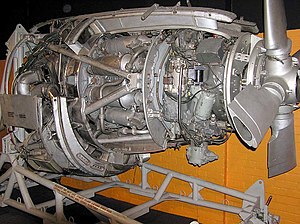Bristol Proteus
| Proteus | |
|---|---|
 |
|
| Preserved Bristol Proteus | |
| Type | Turboprop |
| Manufacturer | Bristol Siddeley |
| First run | 25 January 1947 |
| Major applications | Bristol Britannia, Saunders-Roe Princess |
The Bristol Proteus was the Bristol Aeroplane Company's first successful gas turbine engine design, a turboprop that delivered just over 4,000 hp (3,000 kW). The Proteus was a two spool, reverse-flow gas turbine. Because the turbine stages of the inner spool drove no compressor stages, but only the propeller, this engine was classified as a free-turbine. It powered the Bristol Britannia airliner, small naval patrol craft, hovercraft and electrical generating sets. It was also used to power a land-speed record car, the Bluebird-Proteus CN7. After the merger of Bristol with Armstrong Siddeley the engine became the Bristol Siddeley Proteus, and later the Rolls-Royce Proteus.
Design work on the Proteus started in September 1944, during the course of development the gas generator section was built as a small turbojet which became known as the Bristol Phoebus. This engine was test flown in May 1946 fitted to the bomb bay of an Avro Lincoln, performance was poor due to airflow problems. The 2-stage centrifugal compressor was replaced but similar problems were encountered when the Proteus started ground testing on 25 January 1947.
The original Proteus Mk.600 delivered 3,780 hp (2,820 kW), and was going to be used on the early versions of the Britannia and the Saunders-Roe Princess flying-boat. The versions on the Princess were mounted in a large frame driving a single propeller through a gearbox, and were known as the Coupled Proteus. The Coupled Proteus was also intended to be used on the Mk.II versions of the Bristol Brabazon, but this project was cancelled. Only three Princesses were built, only one of which flew, and by the time the Britannia was ready for testing the manufacturer had decided to equip it with the later Mk.700 Proteus instead.
...
Wikipedia
